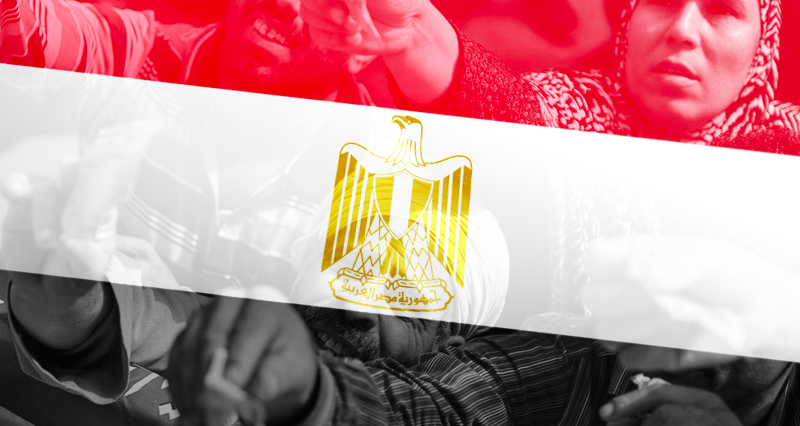Egypt is now experiencing a real economic crisis, reflected in sequential rises in commodity prices and the decline in the country’s fixed foreign exchange reserves, which has caused a significant drop in the value of the pound against the dollar.
Despite what the Egyptian media say, that the crisis is one of the results of the disruption in supply chains caused by the Corona pandemic and the Russian-Ukrainian war, observers and economists believe that the crisis is rather complicated and driven by internal and external reasons that brought the country’s fragile economy to its knees.
An unprecedented crisis
Everyone agrees that this crisis is the worst in decades, as President Abdel Fattah al-Sisi called it ‘unprecedented’ on a telephone interview of a TV program.
The crisis prompted Sisi to announce the state’s intention to hold a national dialogue on various issues and to ease the tension in society that has grown over the past years due to the backdrop of strict measures to combat terrorism and other difficult economic measures that have burdened the middle and poor classes, with a first-of-its-kind gesture.
The President also announced that the Presidential Amnesty Commission has become operational to release additional number of detainees in freedom cases. The Egyptian President also called on the Government to convene a global conference to reveal its future plans to encourage and facilitate the work of the domestic and foreign private sector.
The government also announced its intention to implement a privatization program to sell approximately $40 billion worth of government assets over the next four years. It also brought up for public discussion a draft document titled “The State’s ownerships”, which includes sectors that it plans to leave once and for all, whose contribution it will reduce, and those that want to stabilize its share. This document can be an encouraging roadmap for investors.
For those who do not know; all these steps represent significant and huge retreats in the course of action of the Egyptian state since President Sisi came to power in 2014.
In spite of the doubts about the seriousness of the planned national dialogue and the feasibility of the steps to stimulate the work of the private sector, in light of the regime’s refusal to accept criticism and the growing dominance of the state through the military over the economy, everything that has been announced, reflects the extent of the predicament experienced by the Egyptian economy.
Lost opportunities
But how did the Egyptian economy come to this dead-end? Despite all the opportunities it has had over the past 8 years in the form of soft loans and non-refundable grants from the Gulf countries, and the state of political stability and security that helped the authority to impose the most difficult economic measures without significant political or security costs?
President el-Sisi came to power following the unrest in the country after the 25 January 2011 revolution, due to political and security instability. During this period, Egypt lost its dollar reserves accumulated by the Mubarak regime for many years, due to the decrease in the number of tourists and the shutdown of many factories.
The new president found himself in a financial crisis that prompted him to announce plans to reduce fuel and electricity subsidies gradually over several years, in order to resolve it completely. He also announced a restructuring of food subsidies.
As the crisis escalated, Cairo resorted to request financial assistance from friendly Gulf capitals, which rushed to aid the new regime by providing non-refundable financial grants and billions of dollar deposits, in addition to oil aid with deferred payments.
According to statements by Egyptian Investment Minister Ashraf Salman in 2015, the volume of Gulf aid in the 18 months, following the ouster of President Mohamed Morsi in 2013, was about $23 billion.
The Egyptian government also obtained a soft-interest loan in the amount of $12 billion from the International Monetary Fund, after devaluing the Egyptian currency by more than 120% in 2016.
The government has also succeeded in issuing large amounts of bonds and treasury bills denominated in different currencies over the past years.
Regardless of the amounts obtained by the regime in recent years, in terms of grants, loans and bonds, Egypt’s external debt reached $145 billion by the end of the second quarter of the 2021-2022 fiscal year.
Despite all these loans, aid, and economic measures and 8 years past, they have not been successful in improving the performance of the Egyptian economy. Perhaps it was the opposite; as those funds was like lost opportunities, exacerbating the country’s crisis.
Internal factors
Some believe that the crisis is a result of the interaction of internal and external causes, which led the country to the crisis it is experiencing.
Some say that, on the internal level, the government rushed in carrying out huge infrastructure projects with some without return and others without a guaranteed or quick return, without any hesitation, despite the government’s justifications that there was no alternative to improve people’s lives.
According to the government, the funds obtained were spent in paying dues to foreign oil companies in order to resume their work, constructing huge power stations to fill the energy production deficit, developing projects to improve water use efficiency in a country suffering from a dwindling per capita share of it, constructing new roads and cities to accommodate the population increase, and for the projects to develop the Egyptian countryside, which has been neglected for decades.
While opponents argue that some of these projects could have been delayed, the government implemented them in tight schedules that painfully drained hard currency reserves, although some were not urgently needed.
The expansion of the Suez Canal in a year and the creation of a new administrative capital are examples of projects that opponents deem worth delaying, in a country suffering economic crisis after political turmoil.
Among the criticisms, directed by opponents, include; focusing on spending on non-productive real estate and service projects, which make it more difficult to generate returns that can repay loans and interests.
According to opponents, what made it worse was that the military’s growing reliance on economic companies put private sector companies in unequal competition. The state justified this as a necessity to accelerate the completion of its projects in some sectors and to ensure the availability of basic goods at reasonable prices for citizens who are under exceptional economic conditions.
External causes
But in fact, there were actual external causes that contributed to the country’s predicament. The Corona pandemic caused the tourism sector, one of the sources of hard currency, to stop. The pandemic has also caused a slowdown in the import of some goods to the country when many exporting countries stopped or reduced their exports. The problem was exacerbated by the fact that the government was forced to spend huge sums of more than 100 billion pounds, as allocations to combat the epidemic.
This situation prompted the government to request two new loans from the International Monetary Fund, and it has already received $8 billion.
Before the Egyptian economy began to recover from the repercussions of the pandemic, the Russian-Ukrainian war broke out.
The war caused a rise in the prices of energy, grains and edibles oil globally, which are the commodities that the government imports in a large quantities due to insufficient local production (Egypt is the largest importer of wheat in the world. Russia and Ukraine are its largest suppliers). This resulted in a rapid depletion of dollar reserves.
The measures taken by the US Federal Reserve to raise the interest rate to combat inflation caused the escape of hot money, which Egypt had always relied on in the past years. Some estimate that the money that coming out of Egypt is about 15-20 billion dollars.
This resulted as a sharp decline in net foreign assets in last February, decreased by 60 billion pounds, to -50.3 billion pounds, as a result of the massive exodus of foreign investors from Egypt’s government debt instruments.
Therefore, this is an economic crisis in which internal and external factors combine. It seems that the Russian-Ukrainian war was like the straw that broke the camel’s back.
Controversial urgent actions
Given Egypt’s strategic and national importance, its friends in the region could not leave it to face the crisis alone.
The Gulf States, each in its own way, were in a hurry to bear a hand to Egypt. The Abu Dhabi Sovereign Fund announced its intention to invest no less than $2 billion, by acquiring stakes in some profitable Egyptian companies. Qatar also announced its intention to invest $5 billion in Egypt. Saudi Arabia also deposited $5 billion with the Central Bank of Egypt to support the reserves, bringing the total Saudi deposits of about $10 billion.
Although this immediate aid is appreciated, some have criticized it as a repetition of the same solutions that led to the problem, even though it didn’t exacerbate it. Some critics considered that the crisis forced the state to sell profitable and strategic government assets at prices below their real value, depriving Egypt of important properties that cannot be compensated in the short term.
At the same time, the Central Bank moved the exchange rate of the Egyptian pound, after a stability that lasted about 3 years, to reduce the value of the Egyptian currency against the US currency in the range of 15%. It issued one-year savings certificates at an interest rate of 18%. It also raised the interest rate by 2%, a rate that exceeded the expectations of experts and observers.
Despite this, some specialists oppose the move to raise the interest rates, as it will exacerbate the economic crisis.
According to these economists, inflation in Egypt is imported and it is not the result of an increase in the volume of demand as much as a global increase in costs.
According to them, the government should have reduced the interest rate to encourage investment and private projects, which could contribute to solving the problems of commodity shortages and reducing imports.
They believe that raising the interest rate will increase the cost to be covered by the producers of private sector, following the increase in the borrowing rate.
They confirm that raising interest rates will not bring the hot money back, in light of the confirmed expectations of the US Federal Reserve’s intention to raise interest rates on the dollar more than once during the next two years.
At the same time, some observers warn that raising the interest rate will burden the public budget, as it is the largest borrower from banks. They say debt service interest increases by $25-30 billion with every 1% rate hike.
Specialists supporting the move consider that raising the interest rate on the Egyptian currency as an appropriate response, with the inflation rate rising to 14% last April. They support the move because of their fear of eroding the value of citizens’ savings and the possibility of returning to the dollarization phenomenon Egypt witnessed years ago.
The Central Bank was not satisfied with the decisions of raising interest rates and moving the exchange rate of the pound against the US currency. The bank has taken many measures to limit import and put strict controls on it.
Initially, the Bank acknowledged that the import operations would only take place through the documentary credit method. It also identified import priorities that are entitled to obtain hard currency from banks and stipulated his approval to import some goods. It also prevented the acceptance of any dollars of unknown source in import operations. All of these are measures aimed to control the imports to prevent the depletion of reserves and to prevent the phenomenon of dollarization.
However, the move has upset importers and business owners, as it caused confusion in the import movement and a shortage of production requirements and some vital commodities.
Bleak picture
Despite the manifestations of Gulf support and the decisions of the Central Bank, the crisis appears to be greater than these measures.
The reality is that the gap between the external debt and the monetary reserve in Egypt has multiplied by about 4 times in 12 years, as the external debt increased to 145.5 billion dollars, and the foreign cash reserves decreased to about 37 billion dollars.
According to Bloomberg, Egypt’s external debt was at its lowest level during the past 12 years (in January 2011, external debt was 34.9 billion dollars, while the foreign cash reserve was at about 36 billion dollars).
According to data from the International Monetary Fund, Egypt is the most indebted Arab country and has the largest value of public debt at $409.5 billion, with a ratio of debt to the size of the country’s economy at 94%.
In 2021, Egypt ranked 158th out of 189 countries in debt-to-GDP ratio, and 100th in debt per capita.
The average per capita share of external debt at the end of last December was $1,450, about $4,100 of the public debt, and the average share of a family of 5 people was about $20,500.
According to official figures, the Egyptian government is facing an expected large deficit of $30 billion in the budget for the new fiscal year, which begins next July, spending is expected to reach 2.07 trillion pounds, and revenues will reach only 1.52 trillion pounds, which means a deficit that exceeds $30.5 billion (558 billion pounds).
External debt payments, which are about $16 billion in 2022-2023, are putting a strong pressure on the cash reserve on the one hand, and the increase in external debt on the other. With the addition of principal installments, the total debt service costs is about $53 billion, according to the draft budget.
The indicators of the crisis were reflected in the inflation rates. Data from the Egyptian Central Agency for Public Mobilization and Statistics showed a rise to 14.9% in consumer price inflation during last April, compared to 4.4% in April of the previous year, 12.1% during last March, and 10% during last February.
The picture is getting bleaker with Moody’s keeping Egypt’s credit rating at B2, with the outlook changed from stable to negative. This simply reflects the growing side risks to Egypt’s ability to absorb external shocks. As a result, the interest on loans, that Egypt may seek to obtain in the coming period, will rise.
A vicious circle
In light of this difficult situation, and according to several sources, Egypt is negotiating with the International Monetary Fund to restructure the repayment of the old loan, even with higher interest rates.
However, according to the government, it is seeking to obtain a new loan, which may not be big, and the benefits are likely to be greater and the conditions are difficult.
It seems that the negotiations between the two parties are stumbling due to the conditions, as multiple sources say that among the conditions, there is a commitment to a flexible exchange rate, which may lead to the fluctuation of the dollar price in a way that harms millions of citizens. Also, accelerating the implementation of the privatization program, dismantling and restructuring government economic bodies and offering them for sale, which could hurt a lot of employees, are in question.
Standard & Poor’s expects Egypt to become the largest issuer of sovereign debt among emerging markets in Europe, the Middle East and Africa, with issuances amounting to $73 billion this year, compared to $63 billion last year through its bond issuance.
At the same time, the government is working on various ways to get out of this crisis. On the one hand, it is reviewing the support system and expanding the tax base, and on the other hand, it works to maximize the use of state assets by expanding the sale of state assets.
Fahad Iqbal, Head of Middle East Research for Private Banking at Credit Suisse, sums up the crisis that the Egyptian economy is going through: The Central Bank’s move indicates that conditions in Egypt are worse than we expected, and we cannot rule out the risk of further currency devaluation.
It seems that there are frantic moves of government to handle the crisis by borrowing, obtaining aid from friendly countries, selling economic assets and issuing bonds.
However, observers consider these moves as a repetition of the paths that led to the crisis and into a vicious circle.
Inflationary pressures
According to them, one of the most important imbalances that make inflation a nature of Egypt, is the imbalances in government finances as the result of the growing deficit problems in the public budget, especially in recent years in Egypt with the increasing tendency of the government to invest heavily in the infrastructure sector by borrowing.
According to observers, the expansion of excessive borrowing reflects a problem related to the tax system in Egypt. They see this system as inflation-producing because of its reliance on indirect taxes, such as value-added taxes, which are often deducted at source and cause consumers to bear their costs.
Taxes on goods and services in general, including value-added tax, in the latest government budget represent about 469 billion pounds (out of a total of 964 billion pounds for all tax proceeds). This means that commodity taxes are approximately 48% of the tax proceeds. That toll has more than doubled since 2016.
These inflationary pressures often lead producers to charge increases to consumers, which produces inflation rates. But more importantly, the structure of the tax system in this way (the heavy reliance on commodity taxes as opposed to income, profit, and property taxes) means that taxes are unable to curb inflation in the long run.
So inflation is a structural problem linked to the same economic pattern in Egypt. Thus, even if the government tries to squeeze public spending in the budget by reducing the allocation of wages or subsidies as a percentage of GDP, which the Egyptian government has been doing since at least the eighties and nineties, this will result in the long-term stagflation that disrupts investment spending.
In addition, there are other structural problems in the private sector spending on investment and expansion, due to the fact that credit directed to the private sector at high interest rates, which makes the state lead the investment process through borrowing.
Therefore, in order to tackle inflation from this aspect, increasing the tax revenue as a percentage of GDP is very important in the medium and long term in targeting inflation. The economy also needs other fiscal policies aimed at encouraging savings and investment, which ultimately leads to economic growth in the long term.
Since the returns on government investment expenditure operations are non-existent, weak, or long-term, they are being unable to pay the installments and interest on debts.
As difficult as the crisis is, it may be an opportunity for the government to review its priorities and tracks.
If the government manages to change its borrowing philosophy and redirects loans to efficient projects with appropriate returns, and if it succeeds in encouraging investment, giving the private sector real opportunities, it may be able to increase employment, increase its revenues of hard currency and taxes, stimulate markets, giving the economy a sustainable lifeline.









Leave a Reply